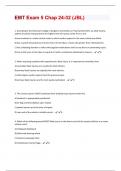Examen
EMT Exam 5 Chap 24-32 (JBL) (Questions & Answers) Rated 100%
- Cours
- Établissement
1. According to the American College of Surgeons Committee on Trauma (ACS-COT), an adult trauma patient should be transported to the highest level of trauma center if he or she: A) was involved in a motor vehicle crash in which another patient in the same vehicle was killed. B) has a systolic bl...
[Montrer plus]



